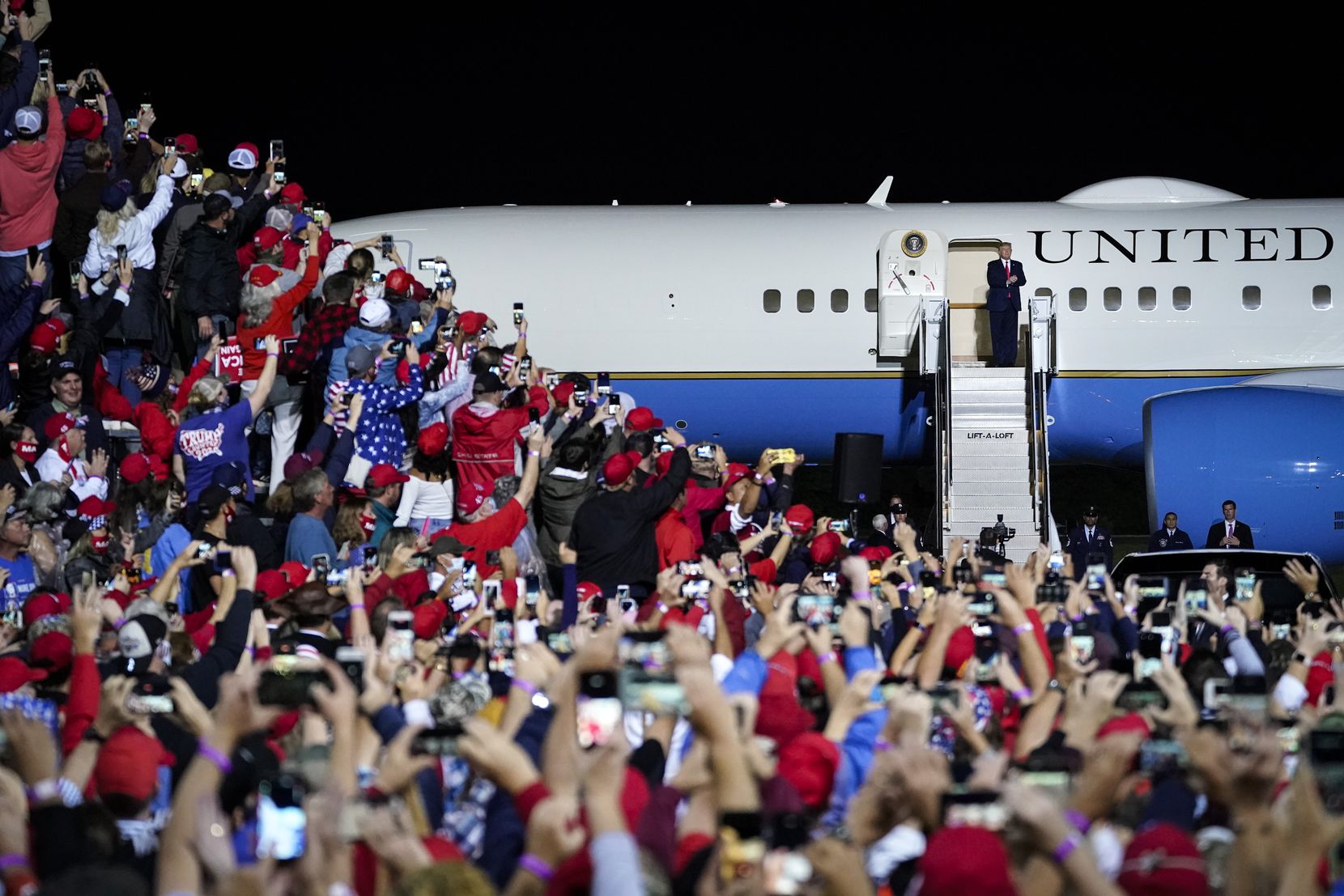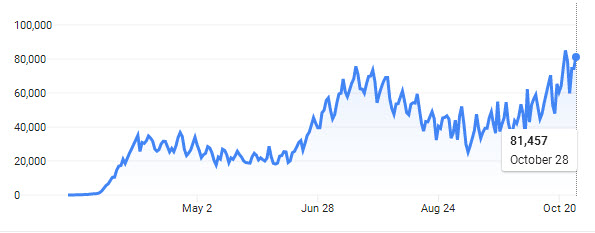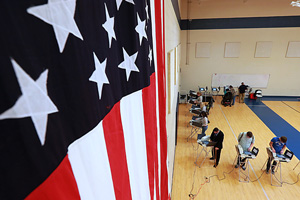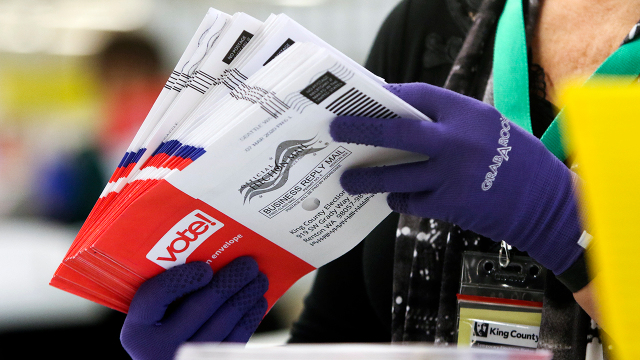Has Trump Created a Death Cult?
President Trump has given up combating the pandemic. So has Vice President Mike Pence, both of them holding superspreader rallies around the country, with Trump every time telling his audiences “We’re rounding the corner” when each day’s new COVID-19 cases — 84,000 on the day before this is written — set new records for the U.S. “We’re not going to control the pandemic”, Trump’s chief of staff 
Trump airport rally
Mark Meadows just admitted, when questioned about a second White House outbreak, “because it is a contagious virus — just like the flu”.
Actually, the president gave up long ago. The days when he decided it best to take an active role, holding late afternoon televised briefings with Drs. Fauci and Birx alongside, are long gone. Even then, less concerned for the nation’s health than the plunging economy on which he was counting for re-election, he was contradicting his experts, tweeting “LIBERATE MICHIGAN” and Minnesota and Virginia, in a rush to lift the lockdown.
When did Trump call it quits? The rally he held in Tulsa on June 20 — an indoor event with spacing guides ripped off seats and few masks in view — serves as good as any as the turning point when Trump discarded the standard “mitigation” protocols urged by his task force of experts. The president had never set the example of wearing a mask (“Somehow, I don’t see it for myself”) and thereafter switched emphasis to “warp speed” vaccine development.
More public events followed Tulsa: five rallies in August, his celebration of his re-nomination August 27th before a closely-seated, mask-free assemblage at night on the South Lawn of the White House, 15 rallies in September, the gathering in the White House Rose Garden September 26th to announce Judge Barrett’s Supreme Court nomination with guests packed tightly in folding chairs and again barely a mask in sight, and daily rallies in October beginning on the 12th once the president had recovered from his own bout with COVID-19.
By one count 27 cases of the disease had engulfed the White House, a dozen from having attended the Rose Garden event. Since then, five aides and advisers to Pence, who chairs the coronavirus task force, it is fair to point out, have tested positive. Summed up by book author Anand Giridharadas better than we can:
“He hosted a super-spreader event to honor a justice who would have the government control your body but refuse the duty to care for it, and when the virus he helped go around came around, he availed of the healthcare he would deny others, financed by the taxes he refuses to pay”.
the plan is: no plan
In August, the president brought into the White House Dr. Scott Atlas as his science adviser. Although a neuroradiologist, with no experience with respiratory diseases, he was not shy about promoting a different policy for dealing with the virus. He was taken with the theory of “herd immunity” and in mid-October, it was presumably he who brought to the White House to meet with Health and Human Services Secretary Alex Azar three epidemiologists who had written a document espousing that radical strategy.
The idea is just what the doctor didn’t order, but it handily rationalizes the caution thrown to the winds policy that Trump and his retinue have been following for months. The manifesto advises that, while older members of the population should be protected, COVID-19 should be allowed to roam freely among the younger generations who are less seriously affected by the illness until herd immunity is reached. That would inhibit the virus from spreading and allow restoration of the vibrant economy that the pandemic has so damaged. In a briefing for reporters, a senior administration official said about the strategy, “We’re not endorsing a plan. The plan is endorsing what the president’s policy has been for months.”
The trio of scientists certainly have the requisite credentials — Martin Kulldorff, an epidemiologist at Harvard University; Sunetra Gupta, an epidemiologist at the University of Oxford; Jay Bhattacharya a physician and epidemiologist at Stanford Medical School. Azar subsequently tweeted, “We heard strong reinforcement of the Trump Administration’s strategy of aggressively protecting the vulnerable while opening schools and the workplace.” Dr. Atlas seems to have won the day.
The document, which argues against lockdowns and for reopening businesses and schools, is called “The Great Barrington Declaration” after a town in western Massachusetts where it was presented under the auspices of the American Institute for Economic Research, a libertarian-leaning research organization located there. It makes no mention of wearing masks, distancing, crowd avoidance, nor any other of the preventives urged for months by scientists and medical professionals. It offers no footnotes nor data traditional to scientific documents. Yet, the website, where the document is posted (in 29 languages), asks for your endorsement and posts, when last we looked, a running count of over 500,000 (using their terms) concerned citizens, over 10,000 medical and public health scientists, and over 28,000 medical practitioners who have signed on.
The declaration claims that herd immunity can be achieved when as little as 10% to 20% of a population has been infected and carries antibodies, a proposition which the mainstream community finds preposterous. Francis Collins, who heads the National Institutes of Health, calls the theory “fringe” and “dangerous”. Fauci called it “ridiculous”. Others interviewed in the Times and Post stories used similar words. The head of the World Health Organization called it “unethical”. It “is just nonsense,” said Dr. Christopher Murray, director of the University of Washington’s Institute for Health Metrics and Evaluation, which produces the widely-cited epidemic model that the White House itself has used in its briefings. A recipe for “carnage” tweeted Gregg Gonsalves, an epidemiologist at the Yale School of Public Health.
Think of vaccines. The standard threshold for herd immunity is at least 60% and more usually 70% of the population having had a disease. At that level of vaccine immunization a disease does not spread. The point is that there must be a high enough proportion of persons in any cluster, gathering, or crowd to cause a virus to have difficulty finding someone with no antibody defenses. It is thwarted from finding a host because the immune systems of enough people have developed antibodies — virus attackers — from having experienced and overcome the disease.
But with only 10% to 20% having been infected, a virus can easily find targets. In the U.S., the over almost nine million who have tested positive for COVID-19 are less than 3% of the population. The number of carriers is assumed to be much higher because of shortfalls in testing — possibly 10% the CDC (Center for Disease Control and Prevention) thinks likely (that is, if the CDC can still be trusted as a scientific organization after being so compromised by Trump administration interference), but any adjusted percentage is far below a conceivable herd immunity threshold.
The Washington Post did an analysis that showed that for the United States, with a population of 328 million, to reach a 65% herd immunity threshold could lead to 2.13 million deaths. This was the pandemic approach in Sweden, which did not turn out well, and it appears now to be the avoidist policy of the Trump White House.
The theory has many other faults. How would older people be protected, as the Great Barrington document blithely assumes? How would the young freely contract the disease without coming into contact with the vulnerable older generations, starting with parents and co-workers? Further, we do not know how long immunity lasts; it is likely to vary depending on how strong a dose of the virus an individual has received. There are already cases of persons becoming re-infected: a A 25-year-old man in Nevada, an 89-year-old woman in the Netherlands who contracted COVID-19 a second time and died. Several others around the world.
How could the nation’s hospitals possibly deal with the onslaught of cases if the disease were allowed to run wild? Does this administration care at all for the safety — both physical and mental — of the nation’s doctors, nurses, and hospital staff? Are they yet another cohort that Trump views as “losers” and “suckers” expected by him to just deal with it and go on doing their jobs? Not a thought seems to have been given to the chaos at hospitals across the nation that abandonment of public health measures will bring.
Ripping of his mask on a White House balcony as he returned from Water Reed Medical Center, Trump told his supporters, “Don’t be afraid of it… I felt great, like better than I have in a long time… better than 20 years ago”, as if to encourage them to do their part — get out there, get sick, and do your patriotic thing to create herd immunity. “Mr. Trump’s statement was meant to cast his illness as an act of courage rather than the predictable outcome of recklessness”, wrote reporters who covered the moment. Here’s what he is telling his rally audiences (the syntax is his):
“A safe vaccine is coming very quickly. You’re going to have it momentarily that eradicates the virus and we’re rounding the turn regardless. You know that. We’ve got the vaccine. I say regardless and they say ‘Well maybe you don’t’. We have it. Great companies. And quickly ends the pandemic.”
With cases spiking higher than ever just as public officials had forecast with the coming of cold weather, the 
opposite is true. Cases in over half the states are surging, midwestern cities and states are reporting that their ICUs are already filled to capacity, there will be no proven vaccine “momentarily”, and its manufacture and delivery to millions will take us deep into 2021. Yet with only votes in mind, Trump has no morals to prevent him from dreadfully misleading his crowds.
Trump loyalists are not told this on Fox News. Instead we have Laura Ingraham touting herd immunity and Tucker Carlson with an essay on masks: “What kind of person covers his face in public? Let’s see, armed robbers do that…So do Klansmen and radical Wahhabists”, etc.
“By our nature, we want to see each other. We need to see each other. Looking at another person’s face is the beginning of connection. Eliminating that connection dehumanizes us.”
Take your masks off, everyone. Get with the herd.
the devoted
Who are these people who go to Trump rallies, these superspreaders? Why are they attracted to events where they are jammed together at risk of contracting a disease that can result in the horrible death undergone by at this writing 226,000, dying helplessly, gasping for air in the final throes of asphyxiation from this disease? A disease that for its survivors can potentially mean months of debilitation called “long covid”; possibly permanent damage to lungs, heart and other organs; a “brain fog” that brings about a mix of short term memory loss and difficulty doing even simple tasks?
Instead, they listen to Donald Trump. “Don’t let it dominate you!”, he intoned. “You’re gonna beat it. We have the best medical equipment. We have the best medicines”. He had, but his fans at the rallies must know that they won’t be treated by a platoon of doctors administering one drug of limited supply and another still experimental and not available at all.
Before taking ill, Trump was not fearful of contracting COVID because he was “on stage so I’m very far away” from the crowds he draws to his rallies. For him they are expendable. During shutdown when Trump could hold no rallies, Olivia Troye, a former adviser to Pence, quoted Trump saying in a corona task force meeting that one benefit of the pandemic was “I don’t have to shake hands with these disgusting people”. Troye said, ““It was clear immediately that he wanted nothing to do with them.”
What makes people follow Trump as their leader, flocking to the daily super-spreader rallies as he hopscotches the country concerned only for re-election. Whether sitting in sports arenas or standing tightly packed at airports, thousands symbolically swear fealty to him not even wearing a mask, not knowing that they are the “losers” and “suckers” he abhors. How have these Americans been led so far from this democracy by no less than the president of the United States that they chant “Lock him up” about Joe Biden, with Trump joining in (“Lock them all up”)? How can this be explained as other than a cult? Add to that a plan to promote herd immunity and it becomes a death cult that would die in staggering numbers if enough of them are fool enough to follow him.



